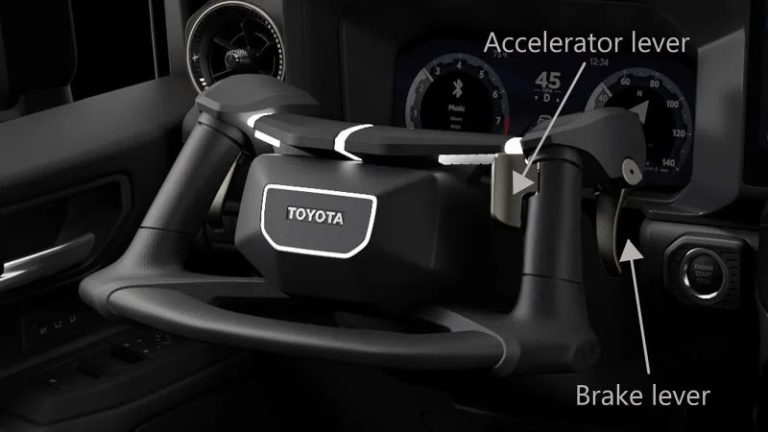In addition to Toyota’s mind-bending simulated powertrains for EVs, the company had another unique driving prototype for us to try at its test center outside of Nagoya, Japan. Toyota calls it Neo Steer, and it was first revealed at the Japan Mobility Show. As you likely gleaned from the headline, the unique aspect of it is that all of the vehicle’s steering and propulsion is controlled from the yoke. The idea is that it could offer both interesting packaging options as well as open up driving to a wider group of people, specifically those without the use of their feet and legs. And while it may not be as unique as something like a manual EV, this one actually seems like it has more practical applications for the future.
The Neo Steer system leans heavily on the steer-by-wire steering yoke design that Toyota will be offering on the Lexus RZ electric car – we already tried that out once, but Toyota’s made some changes in between then and now. That said, the way it operates in principle is the same. Because there’s no physical connection between the wheel and the steering rack, it opens up the ability for Toyota to significantly shorten the ratio between steering wheel inputs and the resultant degree of front-wheel steering, all without resulting in super heavy steering, and with the ability to add other assists if needed. This is all important, as one of the targets Toyota wanted to hit for Neo Steer was to ensure that not only would you not have to go hand-over-hand for tight corners, but to also reduce the amount of steering lock necessary for people with limited shoulder and arm movement. And even without that in mind, with the throttle and brake controls on the yoke, Toyota wouldn’t want any driver getting crossed up or uncomfortable while using those other controls.
Those “other controls” are extremely similar to motorcycle controls. The throttle consists of a twisting, spring-loaded collar on the right side of the steering yoke. For braking, there’s a bicycle-style pull lever on the left side. Presumably, there isn’t any reason these couldn’t be swapped, or even for Toyota to put redundant controls on each side. In fact, the more finished concept designs (shown here) show brake levers on each side. Additionally, controls that usually sit on steering column stalks such as the turn signals and wipers have buttons and switches mounted to the yoke for use via one’s thumbs. This is practical, as the idea is your hands are always in the same position on the wheel.
The prototype we drove had controls that were a bit more rudimentary than the concept. The yoke was just the same unit from the RZ, and the twist throttle was a simple gloss plastic piece with a raised section to offer some leverage and reference for the amount of throttle applied. The brake lever really did seem to be taken from a bicycle, though the lever movements were translated to a brake-by-wire transmitter that would send inputs to the receiver on the master-cylinder unit that would in turn operate the hydraulic brakes.
The first impressive thing we noticed pulling away from the prototype Toyota bZ4X‘s parking space was the smoothness and comfort of the twist throttle. Certainly, having a bit of motorcycle experience makes it feel a bit more natural, but light spring tension and plenty of throttle travel made it easy to find the right amount of throttle and hold it. Plus, inputs weren’t jumpy. The entire right handle doesn’t twist, either, just the collar at the top, so you can sort of roll it between your thumb and forefinger, which helps avoid uncomfortable wrist positions as well as ensuring you maintain a good grip on the yoke.
The brake lever didn’t feel quite as polished. It didn’t have the precision or smoothness of operation of the throttle, and it was a little tricky to figure out just how much squeeze would engage the brakes. But the positioning was very comfortable, and it was easy to operate, which really is the most important aspect. There could be some very interesting potential in providing force feedback through the brake lever, too, similar to what you might find on modern PlayStation and Xbox controllers.
The steering was the biggest surprise. At low speeds and in tight maneuvers, it’s fast enough that it can be a little jumpy, with lots of steering resulting from small movements. But at quicker speeds with less steering lock needed, it was fun. The result is something that genuinely feels go-kart- or race car-like. And that shouldn’t be surprising, since that’s how those vehicles have their steering set up. But of course, the steering effort was extremely light, so you don’t need huge muscles to manage. On slightly wider corners, it didn’t take long to be smooth and steady holding the line. A little bit more weight and some of the progressive feedback from the regular RZ steer-by-wire system would be nice, but again, that’s an easy change.
So, what does this mean for the future of Toyota and Lexus? The really obvious potential of Neo Steer is as an accessibility device for people who can’t use foot pedals. And if steer-by-wire becomes more common, it could be a really easy way to offer that extra accessibility, since it could potentially only require different software and a different wheel plugged in to make a vehicle accessible. It would also eliminate bulky hand controls that have to work with existing vehicle inputs. There’s also potential for this system to play nicely with autonomous systems, since you could have all your manual controls packed away neatly in the wheel and retractable for autonomous driving, without having to fuss with pedals. It could even offer more foot room for the driver and more comfortable leg positioning for all drivers, since there wouldn’t be pedals in the way. Steer-by-wire in general, even without the hand throttle and brakes, offers the potential for freeing up space and improving packaging for car parts, people and cargo. There’s even the potential for offering a variety of different steering programs – that are much more varied than today’s common “comfort” vs. “sport” steering settings that largely just change steering effort – to adjust based on personal preference (speed, feedback, etc.).
With all the possible benefits and the fact that Toyota’s system feels well-developed as-is, we think we’ll see more about it in the coming years. And that should be good news for drivers of all kinds with all abilities.
Related Video:
Useful Resources For Everyone
Boost Your Web Site Traffic: Mytraffic Powerline
Explode Your Web Site Traffice: SparkTraffic
Start your affiliate journey here: OLSP Academy
Best Solution To Create Videos: Create Studio Pro
Best Solution To Create Graphics: ClickDesigns
Smart Chat Automation: ChatterPal
Multi-Purpose Video Maker: Avatar Builder
Multi-Purpose Video Creator: Video Creator
AI Human Spokesperson Videos: HumanPal
AI Content Writer & AI Human Voices: HumanTalk










